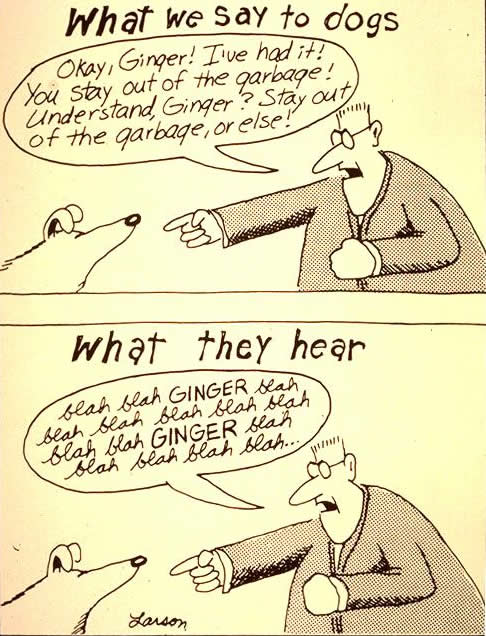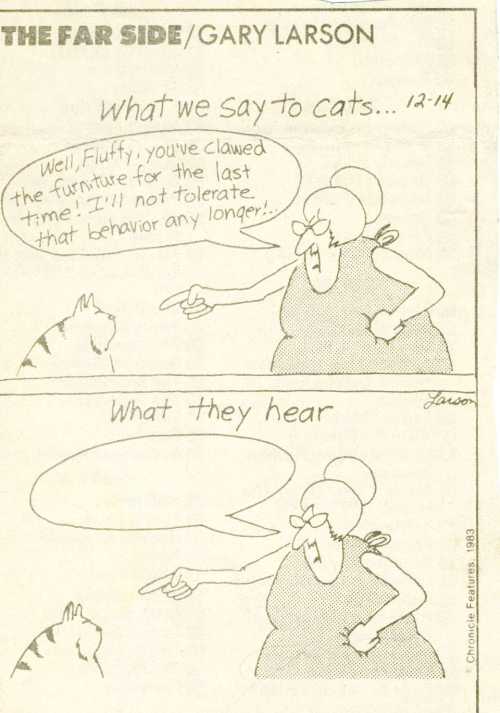January 21, 2008
Dog language mailbag
In response to "It's a dog's life -- 0.3 bits at a time", several people sent me links to this video clip of a Siberian Husky vocalizing "at his own barking and his playdate's barking". (I guess the sounds he's responding to are being played back from a recording.)
(If that's not enough for you, there's more...)
At the end of my earlier post, I added a note from Laurence Sheldon Jr., which I repeat below:
We have just one dog, and I have no notion of just how a study involving more than one individual would turn out, but there is no doubt in my mind that we (wife and I) can correctly differentiate among "I'm bored and going out sounds like something to do.", "Squirrel in the bird feeder!", "I gotta go!", "Car! You going somewhere in the car?!", "I think I heard the garage door open and I want to go [greet Pat|greet Larry|get into the car before [Pat|Larry] notice.]!", and "[Pat|Larry] has been gone quite a while, I want to check the garage for them.".
Some of these we think we can identify without seeing the dog ("Squirrel!") or knowing which of four doors she is at.
I asked whether all of these vocalizations just barks, as opposed to whines or growls or yips or howls or other sorts of canine sounds. Larry's response:
In the case of our dog I would say "inflected barks" as if I knew what the word "inflected" meant. (I am by no means a linguist.)
To me the "word" that means "Squirrel!" is an excited-sounding short bark repeated, while the one that means "I gotta go!" is similar but lacks a joyful quality that I am not bright enough to describe.
Similarly she has a bark when on the outside of the door seems to mean "I'm still here, but I don't want to come in." (she runs loose in our yard when she is out.) and a very different sound that means "Let me IN!" with a noticeable increase in urgency as it gets colder or we don't react as fast as she would like.
She rarely growls, and she whines only when she wants us to get up during the night to let her out. (If the whine is not responded-to, she follows up with the "I gotta go!" bark.)
There are lots of dogs in the neighborhood and most are vocal a lot of the time, but only the boxer next door seems to use different "words" for different situations. Or the rest are really boring conversationalists.
With Proxmire dead and gone, why can't somebody get funding for a serious study here?
Melissa Bollbach sent a long note -- I'll divide it up and respond to the pieces.
I think you're right, it's unlikely that all the dog vocalizations in the study were barks. I volunteer at a shelter and have taken some behavior classes, and I don't know many dogs who would offer a single well-defined bark in the "fight" and "stranger" situations. Fight in particular seems to require a stream of growling/snapping more than barking, which is why it's easy to recognize. Notice that the play/walk/ball situations were harder.
She asked about the various situations involved:
I wonder how careful they were about the difference between play and ball. For a lot of dogs ball is a subset of play (unless play specifically involves more than one dog), and depending on whether the ball is accessible or just shown to the dog, ball and walk could be a similar excited/anticipation bark. Also, what did they use for "alone"? If my dog is alone, he doesn't bark unless hears a stranger, while my ex-boyfriend's dog's alone bark is a pitiful "why can't I come on the walk?" (I'm not cruel, I just walked them separately because the pitiful dog pulls on leash.)
The authors of the cited paper are quite explicit about this:
"Stranger" (N = 1802): The experimenter (male, age 23 years) was the stranger for all the dogs, and appeared in the garden of the owner or at the front door of his/her apartment in the absence of the owner. The experimenter recorded the barking of the dog during his appearance for 2–3 minutes.
"Fight" (N = 1118): For dogs to perform in this situation, the trainer encourages the dog to bark aggressively and to bite the glove on the trainer’s arm. Meanwhile the owner keeps the dog on leash.
"Walk" (N = 1231): The owner was asked to behave as if he/she was preparing to go for a walk with the dog. For example, the owner took the leash of the dog in her/his hand and told the dog "We are leaving now".
"Alone" (N = 752): The owner tied the dog to a tree with a leash in a park and walked away, out of sight of the dog.
"Ball" (N = 1001): The owner held a ball (or some favorite toy of the dog) at a height of approximately 1.5 m in front of the dog.
"Play" (N = 742): The owner was asked to play with the dog a usual game, such as tug-of-war, chasing or wrestling. The experimenter recorded the barks emitted during this interaction.
Melissa goes on:
As a bachelor of arts in linguistics I think this is crap, and as a dog owner and amateur behaviorist I think this is crap. Your writing on science journalism has been in my thoughts lately as I've been trying to find recent peer-reviewed research on whether dogs can learn by true imitation (long-held scientific belief is no, but most owners believe yes, and some studies suggest maybe). Dog behavior is like linguistics in that many layperson dog owners consider themselves experts and don't care about scientific research.
I don't think that the Molnár et al. paper is crap by any means, though the Springer press release about it, and the resulting media coverage, certainly had a high organic nitrogen content, not speak of phosphorous and potassium. Melissa concludes:
I am now an engineer, enjoying a profession where expert opinion does tend to be respected by the public, in spite of the fact that language and animal behavior are really a lot more complicated and mysterious than engineering. And therefore more fun, but unfortunately lower-paying.
Dan Melamed sent the Far Side cartoon reproduced below. The most relevant Far Side cartoon, as I mentioned in the last post, is the one where where Professor Milton invents a device that translates from Dog to English, and goes down a street full of barking dogs, only to discover that they are all saying "Hey hey hey hey hey hey..." But that one doesn't seem to be on the internet, and this one, about translation the other way, is also good:

And Geoff Nathan wrote about "a great Nicole Hollander cartoon, which unfortunately I can't find a copy of online at the moment", where
A scientist is being interviewed about the fact that he has decoded the language of cats. Unfortunately, he says, they only say two things:
'Feed me, you fool'
and
'Everything here is mine.'
[Update -- James Russell writes:
I remember that Far Side cartoon, but it had a second half which made it much funnier.
There was "What we say to cats", with a scolding of Fluffy for something or other, and then there was "What they hear", which had an empty dialogue balloon.
And courtesy of Karen Davis, here it is:
 ]
]